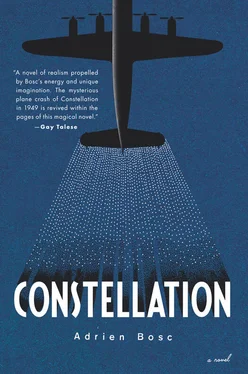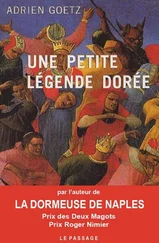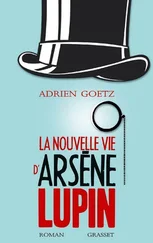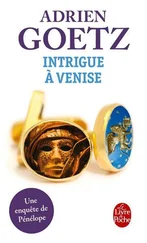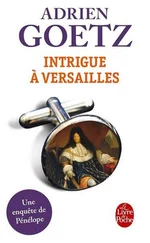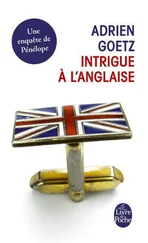What a surprise, on the night of October 27, to find the virtuoso standing beside them at the foot of the boarding ramp. Rachel can’t get over it. She has kept the program of the farewell concert and makes a point, once they are on the plane, of getting the violinist to sign it.
Guy had been impressed by his visit, and his articles reflected his enthusiasm. The Holy Year, he said at a Canadian embassy lunch the day before their departure, would leave its mark on the history of Christianity.
Guy’s articles encouraged Quebec’s Christians to sign up for trips organized by their parishes. Did any follow his recommendation? No one knows, but exactly a year later, on October 27, 1950, a group of Canadian pilgrims landed in Lisbon on the ocean liner Columbia . After a visit to the town of Fatima, they made a first stop in France at Lourdes, then went on to Paris and Lisieux. High point of the pilgrimage, an audience with Pope Pius XII at the Vatican on November 13. From there they went to Ciampino Airport, where they boarded a plane to go back to Paris. The aircraft, a DC-4 built by Curtiss-Reid, took off at 2:16 p.m. An hour later, the plane slammed into a mountain, the Grande Tête de l’Obiou in the Isère, on the heights above La Salette. There were no survivors. Rescuers reached the wreck the next day to discover the extent of the catastrophe. The most far-fetched theories were proposed to explain the accident, with some saying that the plane was downed by the Russians, anxious to recover secret Vatican documents traveling with the pilgrims to the United States.
Crocodiles don’t follow funerals, as they can’t cry.
— Francis Picabia
Orly, November 8, 1949 — The Air France company celebrates its two-thousandth transatlantic flight with great pomp. Champagne, caviar, and lobsters replace the regular airplane meals.

Église Saint-Augustin, Paris, November 9, 1949 — The night before, the eleven coffins of the crew members of Constellation F-BAZN were placed in the crypt of the Church of Saint Augustine. Family, friends, unknowns, and officials from the company and various ministries gathered at 11:00 a.m. to pay their last respects to the aircrew fatalities. In the center of the nave, under metal arches that support large wrought-iron flower-shaped chandeliers, an honor guard of colleagues from the company extends on either side from the benches to the altar. Wearing uniforms that bear Air France’s sea horse insignia, nicknamed “the shrimp,” the company’s flight personnel stand in ranks. The Église Saint-Augustin is a stigma at the heart of the capital, a big wedding cake of varied Byzantine inspiration, a mixture of white stone and metal arcades, an absurdity as inappropriate as Sacré-Coeur Basilica, that rude insult to the defeated ideals of the Paris Commune. Before the service, hundreds of curious Parisians walk in solemn ceremony as far as the caskets, an influx that stops only when the doors are shut. In the front rows, grieving families, ranks of gauze veils and dark suits; a few rows back, the officials, consequential ones, including Max Hymans, chief executive officer of Air France, representatives from the French cabinet, the Seine prefecture, the police, the air force, and, on the end, Inspector Lévis-Mirepoix, who ferried the dead souls from the Azores. The absolution of the dead is performed by Monsignor Leclerc, then the crowd disperses to the sustained notes of the grand organ. In the forecourt, the caskets of the aircrew are loaded into hearses and scattered to their places of burial: Jean de La Noüe, the captain, returns to his village on the Brittany coast, Pléneuf-Val-André.

Central office of the funeral home, 66 Boulevard Richard-Lenoir — The passengers of Constellation F-BAZN are laid out for their families. On each casket, the name and official certificate of identity. The final identification of the bodies is to occur before they are transported to the cemeteries, soon they will return to family crypts — in the Basque country for the shepherds, in Alsace for Amélie Ringler and René Hauth, in L’Haÿ-les-Roses for Paul Genser, in Bagneux for Jo Longman, and in the Père-Lachaise Cemetery for Ginette Neveu and the six unidentifieds, who will be grouped together in a Tomb of the Unknown Passenger. It was built for the nameless bodies when, with their identities in doubt, the foreign nations to which they possibly belonged declined to repatriate them. Their number included, perhaps, Remigio Hernandores, Hanna Abbott, Yaccob Raffo, Eghline Askhan, Mustapha Abdouni, and James Zebiner, stateless persons in East Paris.

Saint-Laurent Cemetery, 805 Avenue Sainte-Croix, Montreal — The bodies of Guy and Rachel Jasmin arrive in Montreal on November 7, and, two days later, the Québécois journalist community congregates at the Church of Sainte-Madeleine d’Outremont to pay its respects to the editor in chief of Le Canada and his mother. Every newspaper in the country, even Time magazine from New York, has sent a representative. Guy’s friend Arthur Prévost reads aloud a postcard that Guy wrote the day before the flight.

Church of Notre-Dame-de-Lourdes, Casablanca, November 10, 1949 — Casablancans have been filing past the boxer’s mortal remains continuously for two days. The crowd’s pain-filled fever, shadow image of its victory celebration. A long line snakes out into the tree-bordered alleyways of Lyautey Park. Under Morocco’s dazzling autumn sun, devastated faces, somber and stricken, wait patiently in hopes of a few moments of quiet recollection. Nightfall doesn’t stop the procession of anonymous mourners, and the garlands and wreaths collect around the casket, which is decorated with a capital “C” and surrounded by the ropes of a boxing ring. At regular intervals, the guards clear the room of its offerings. Ten guest registers have already filled with signatures. Casablanca has come to a halt, the funeral will last as long as it has to, the suffering is enormous.
At 10:00 a.m. on November 10, the champion’s funeral service is held at the Church of Notre-Dame-de-Lourdes. It takes nearly fifty taxis to transport the accumulated heaps of flowers there. The motorcade to Anfa resembles a military parade. The weather is splendid, the day a special holiday, and seventy thousand people gather around the church building. Inside are the Moroccan royal family; the wife of Resident General Juin; M. Francis Lacoste, minister plenipotentiary; M. Négrier, director of the civil cabinet; M. Grémaux, president of the French Boxing Federation, who arrived that very morning at 4:00 a.m. In the front rows are the Cerdan family, Marinette and her three children, the cousins, uncles, friends. René Cerdan, the nephew, an apprentice boxer and Marcel’s sparring partner this past summer, sprinkles holy water. Inconsolable, he collapses on the casket. Former manager Lucien Roupp is also on hand. After the service, the procession winds around to Ben M’Sik cemetery. The priest delivers the funeral oration, and the gravediggers fill in the first shovelfuls of dirt.

Return to the central office of the funeral home, 66 Boulevard Richard-Lenoir — Ginette Neveu was to be buried on November 9 at the Père-Lachaise Cemetery. As to Jean, his body was never found. The grave marker in section 11 was carved with a violin in bas-relief, and on the headstone was a bronze medallion with the profile of the violinist and this inscription:
Читать дальше
